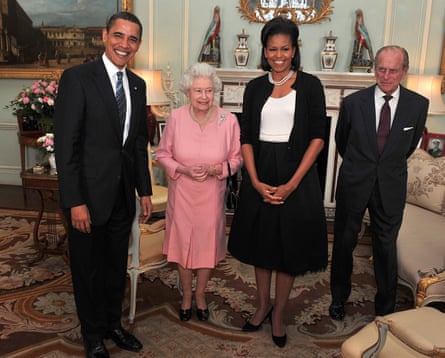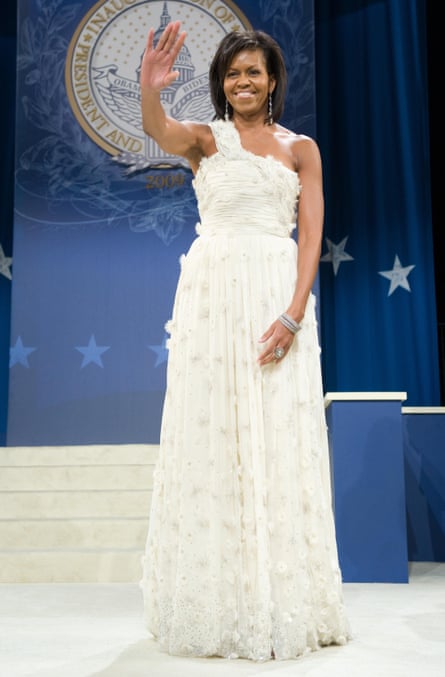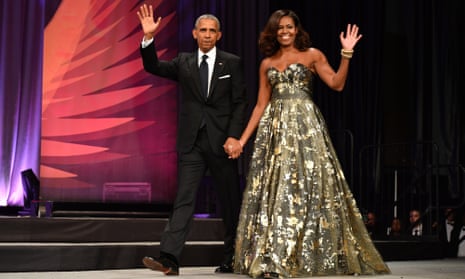When Michelle Obama gets on the microphone, the world listens. Her speech at the Democratic convention in July was judged by many to be the best of the week, reaching the emotional and inspirational heights that Hillary Clinton’s presidential campaign has sometimes struggled to achieve. Her turn on Carpool Karaoke with James Corden this summer, singing Beyoncé and Stevie Wonder, has, at the time of writing, been watched nearly 44m times on YouTube.
But for most of the eight years she has lived in the White House, there has been no microphone. Obama is seen a good deal more than she is heard, so how she looks has taken on disproportionate significance. Her image sets the emotional tone for the White House, becoming a symbolic ideal for other women, for other wives and mothers. Every new hairstyle has been combed as a cipher for a change in the national mood; every dress evaluated for the values it embodies.

There is no denying that this feels retrograde for a woman of Obama’s intellect and background. There is a call-and-response rhythm to this kind of coverage, with every fashion feature on her wardrobe triggering an opinion piece raging at this unbefitting treatment of a high-achieving lawyer with degrees from Harvard and Princeton. Yet, contrary to what many expected, Obama herself has played the role in a notably traditional key. In contrast to her predecessor Hillary Clinton’s battles over public healthcare, she has adopted relatively uncontroversial causes: family nutrition, childhood health and girls’ education, issues that sit neatly around her self-proclaimed identity as Mom-In-Chief. While these causes are, perhaps, more culturally loaded than they first appear – the campaign against childhood obesity has a more progressive slant when you take into account the fact that the issue disproportionately affects low-income and black families – they have frustrated those who hoped for a more radical rewrite.
Obama has followed in the first lady tradition by putting fashion centre stage of her public persona. On the night of her husband’s election to office in 2008, she wore a Narciso Rodriguez dress in a fiery red-and-black speckle pattern. The fashion press reported the pattern as “dégradé”, while others went with “lava lamp”. To wear a very eye-catching dress at such a moment made it clear that Obama had no intention of allowing the White House to cramp her style. She had broken an unspoken rule of modern culture, which holds that a serious person must have a sober wardrobe.

Until Obama, the iconography of the first lady revolved around Jackie Kennedy. There had been glamorous president’s wives since – Nancy Reagan with her Dynasty gowns, say – but the notion of first lady chic remained almost synonymous with that sunny yet streamlined early-1960s style that is for ever Camelot. Half a century later, wives of heads of state all over the world are still measured against Kennedy, but the comparison is sharpest in the White House. Where her predecessors had tiptoed around the edges of Kennedy style, as if anxious to avoid the comparison, Obama has embraced many elements of the look and made them her own. The sleeveless shift dresses she favours are a direct link, as are the outsize strings of pearls, often framed by wide-set necklines. Even elements of the two women’s hair and makeup are similar, despite their physical difference: note the full, stiffly curled hair and the penchant for false eyelashes.
The Kennedys represent an American ideal that is classy and democratic, and Obama has used fashion to ally herself and her husband with that same message. The visual connection with the Kennedys draws the eye to the obvious difference: their skin colour. It’s a way of emphasising the historic nature of the Obamas as the first black family to live in the White House, while at the same time telling the world that this family, and this administration, is traditionally American.
At the first inauguration, in January 2009, Obama wore a dress and matching coat in an unusual shade of pale greenish yellow that observers struggled to put a name to. (The Guardian went with lemongrass.) Her elder daughter, Malia, wore a purple coat with black scarf and gloves; her younger daughter, Sasha, a pink coat with orange scarf and gloves. The colours made for a dazzlingly confident family portrait. Other elements of the look were formal, even traditional (the first lady’s sleek leather gloves, the two girls in their cosy, buttoned-up coats), but the colours were modern, the cheery brights of a holiday snap rather than the sepia tones of an official photograph. That was the day Obama took first lady chic and made it modern and down-to-earth. Later that year, on a state visit to Britain, she wore an Azzedine Alaïa cardigan to meet the Queen. “You don’t go to Buckingham Palace in a sweater,” sniffed the designer Oscar de la Renta – but he was already out of touch. Obama’s approachable, real-life wardrobe had struck a chord.

Without wearing a single outfit that could be considered truly rule-breaking, Obama has rewritten the playbook. In early 2009, when the first lady’s official website was launched featuring a photo of her wearing a sleeveless dress, the Chicago Tribune reported that it had received hundreds of online responses, many of which criticised the look for its inappropriate informality. Since then, the trend for the sleeveless dress as grownup but fun, dressy but comfortable – fuelled, in huge part, by Obama herself – has grown and grown. She made it OK for a middle-aged woman to wear a dress showcasing arms that speak of serious push-ups, as well as those signature warm Mobama hugs. In that sense, she represents a generation growing old in a different way. Many of her fashion choices – from the girlish, bridal Jason Wu gown she wore for the first inauguration to the full skirts she often favours for daytime – are looks that not long ago would have been thought too young, too cute, for a woman in her 50s to carry off. Instead, she has captured something of the confidence of a generation who will not accept that they should slip into the shadows.

Obama has consistently played down any interest in fashion. “It’s so hard. I’m kind of a tomboy-jock at heart, but I like to look nice,” she told ABC news in 2008. But she has steered her image carefully nonetheless. When she appeared on the cover of American Vogue in March 2009, she did it on condition that the choice of dress was hers, without input from the Vogue team, and that she used her own hair and makeup stylists, something the magazine had not agreed to before. Even the designer and film-maker Tom Ford, renowned for his control freak tendencies, alluded to Obama’s strictures in a recent interview with the Hollywood Reporter, when he related the experience of dressing the first lady for an audience with the Queen in 2011. “Doing something like that is easy because you’re dictated to,” he said. “‘She needs to wear that colour, she has to have gloves, she doesn’t like this, she doesn’t like that.’ It’s pretty simple.”
Simple, but strategic. Obama’s mastery of fashion is less about the clothes than about a modern woman’s innate understanding that visual messaging is a crucial part of public life. As she told American InStyle magazine last month, “We can fool ourselves into thinking that everybody is still watching the evening news, but I live with Generation Z, and I know that their habits, the way they take in information, are so different… We’ve got to meet our constituents where they are, and they’re on Snapchat.”
Obama has been on Snapchat since June. Her opening post? A selfie and the emoji of the girl in pink, her hand raised. This is a woman who doesn’t need a microphone to get her words across.

Comments (…)
Sign in or create your Guardian account to join the discussion